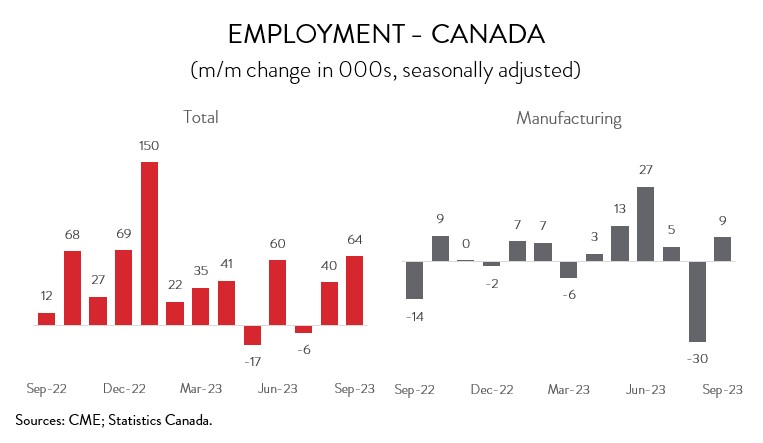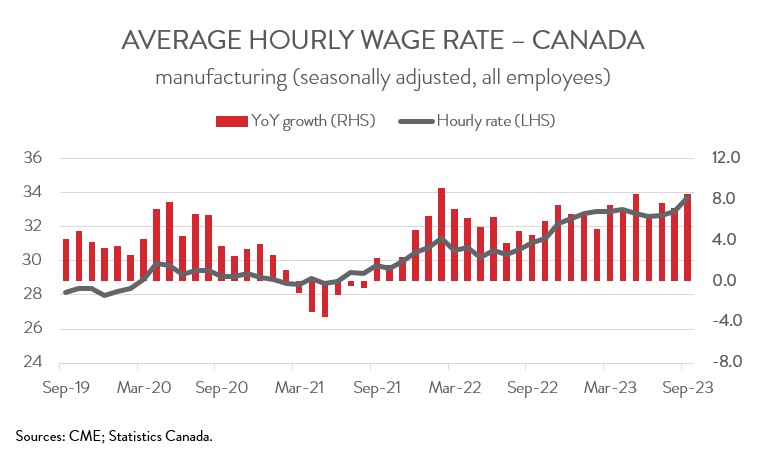Labour Market Trends
Labour Market Trends
September 2023
Economy Continues to Add More Jobs Than Expected in September; Manufacturing Sees Modest Gain
HIGHLIGHTS
- Employment was solid again in September, rising by 63,800 (+0.3%).
- The increase spanned 10 of 16 industries, though almost all the gains came in the highly seasonal education sector.
- Manufacturing employment climbed by a modest 8,800 (+0.5%) in September, partially offsetting the 29,500 jobs lost in August.
- The headline unemployment rate remained unchanged at 5.5% in September, while the jobless rate in manufacturing increased 0.6 percentage points to 4.3%.
- Year-over-year wage growth in the manufacturing sector accelerated from 7.2% in August to a near-record high of 8.5% in September.
- Total employment was up in 7 of 10 provinces, with Quebec, BC, and Ontario all posting double-digit gains. The job growth in manufacturing was concentrated in Quebec.
- Despite the strong headline number, the details of the report were much less impressive. With inflation also coming in below expectations in September, the Bank of Canada is likely to hold its policy rate steady at next week’s meeting.
EMPLOYMENT UP BY 63,800 IN SEPTEMBER, BUT REPORT’S DETAILS LESS IMPRESSIVE
Employment was solid again in September, rising by 63,800 (+0.3%). However, the underlying details of the report were much less impressive. The gains were driven by part-time work and, as a result, total hours worked actually edged down 0.2%. Also, private sector employment increased by just 1,100.

At the same time, while the increase in employment spanned 10 of 16 industries, almost all the job gains came in the highly seasonal education sector (+65,800). The only other industries to post notable job growth were transportation and warehousing (+18,900) and accommodation and food services (+11,000). These gains were partly offset by pullbacks in finance, insurance and real estate (-19,800), construction (-17,500), and information, culture and recreation (-12,100).
The decline in total hours worked suggests that the Canadian economy continues to move sideways. With inflation also coming in below expectations in September (3.8% on a year-over-year basis), the Bank of Canada is likely to hold its policy rate steady at next week’s meeting.
MANUFACTURING EMPLOYMENT INCREASES MODESTLY
Manufacturing employment increased by a modest 8,800 (+0.5%) in September, partially offsetting the 29,500 jobs lost in July. With this gain, manufacturers have added 43,000 jobs over the last 12 months. Accordingly, employment in the sector stood at 1.820 million in September, exceeding the 1.8-million mark for the fifth consecutive month, a level not seen since late 2018. Looking ahead, however, the manufacturing sector continues to face numerous headwinds that will likely limit job creation over the near term, including ongoing workforce challenges, high interest rates, and a slowing global economy.
MANUFACTURING UNEMPLOYMENT RATE SURPASSES 4%
The headline unemployment rate was unchanged in September and stood at 5.5% for the third consecutive month. In contrast, the jobless rate in manufacturing increased for the second month in a row, rising 0.6 percentage points to 4.3%, surpassing the 4-per cent mark for the first time since September 2021.

WAGE GROWTH IN MANUFACTURING ACCELERATES TO NEAR-RECORD HIGH
Headline wage growth remained brisk, with average hourly earnings on a year-over-year basis ticking up from 4.9% in August to 5.0% in September. Pay gains were significantly higher in manufacturing, even though a rising unemployment rate signals that labour market conditions are easing somewhat. Year-over-year, wages in the sector accelerated from 7.2% in August to a near-record high of 8.5% in September. The average factory worker earned $33.71 an hour in September 2023, up from $31.07 an hour in September 2022.

QUEBEC, BC, AND ONTARIO POST DOUBLE-DIGIT JOB GAINS
Regionally, the increase in total employment spanned 7 of 10 provinces. Quebec (+38,700), BC (+25,700), and Ontario (+19,900) all posted double-digit gains. In proportional terms, job growth was also impressive in PEI (+2,700). On the downside, employment declined by 37,800 in Alberta, largely offsetting cumulative gains of 44,000 in the previous four months.
In the manufacturing sector, employment was up in only three provinces in September, with the bulk of gains taking place in Quebec (15,700). Manitoba (+2,600) and Saskatchewan (+2,500) were the other two provinces to add manufacturing jobs last month. Taking a longer-term view, manufacturers in Ontario (+20,000) have created the most jobs over the past year, while manufacturers in BC (-5,000) have shed the most workers.
